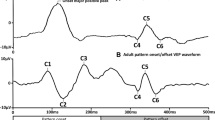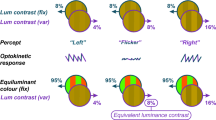Abstract
The averaged lambda wave elicited by saccadic eye movements across a checkerboard pattern has been reported to differ from checkerboard reversal evoked reponses, even when the electroencephalographic responses were corrected for the artefact caused by the movement of the dipole moment of the eye itself. Because of these differences it was suggested that the recording of the lambda wave might provide extra information in pathological circumstances. We performed experiments in which the parameters of the pattern (high contrast checkerboard pattern, 20′ checks, large field 72 × 72 degrees) shift across the retina were carefully adjusted. For instance, eye movements were made across an integer and odd number of checks in order to mimic the pattern reversal. Furthermore, the timing of the pattern movement in the pattern reversal condition was adjusted so as to simulate the saccadic eye movement. The results seem to suggest that the reported dissimilarities between pattern reversal and eye movement evoked responses can be accounted for by the small differences of the retinal shift in the two conditions.
Similar content being viewed by others
References
Barlow JS, Ciganek L. Lambda responses in relation to visual evoked responses in man. Electroencephalogr Clin Neurophysiol 1969; 26: 183–192.
Billings RJ. Are averaged lambda waves contaminated by eyemovement? Electroencephalogr Clin Neurophysiol 1985; 61: 589.
Dagnelie G, de Vries MJ, Maier J, Spekreijse H. Pattern reversal stimuli: Motion or contrast? Doc Ophthalmol 1986; 61: 343–349.
Duwaer AL, Spekreijse H. Latency of luminance and contrast evoked potentials in multiple sclerosis patients. Electroencephalogr Clin Neurophysiol 1978; 45: 244–258.
Ebersole JS, Galambos R. Lambda waves evoked by retinal stimulation in the absence of eye movements. Electroencephalogr Clin Neurophysiol 1973; 35: 39–47.
Evans CC. Spontaneous excitation of the visual cortex and association areas - lambda waves. Electroencephalogr Clin Neurophysiol 1953; 5: 69–74.
Feinsod M, Hoyt WF. Subclinical optic neuropathy in multiple sclerosis. J Neurol Neurosurg Psychiat 1975; 38: 1109–1114.
Gaarder K, Krauskopf J, Graf V, Kropfl W, Armington JC. Averaged brain activity following saccadic eye movement. Science 1964; 146: 1481–1483.
Gastaut Y. Un signe electroencephalographique pue connue: les pointes occipitales survenant pendant l'ouverture des yeux. Rev Neurol 1951; 84: 640–642.
Gastaut H, Gastaut Y. The mechanism of potentials evoked in the occipital region in human subjects by saccadic movements of the eyes. Electroencephalogr Clin Neurophysiol 1956; 8: 720–721.
Goovaerts HG, van Veen C, Meekes MAMM. A general purpose microprocessor for medical instrumentation and electrical stimulation. J Biomed Eng 1984; 6: 90–96.
Green J. Some observations on lambda waves and peripheral stimulation. Electroencephalogr Clin Neurophysiol 1956; 9: 691–704.
Halliday AM, McDonald WI, Mushin J. Delayed visual evoked responses in optic neuritis. Lancet 1972; 1: 982–985.
Heuningen van R, Goovaerts HG, de Vries FR. A low noise isolated amplifier system for electrophysiological measurements: basic considerations and design. Med Biol Eng Comp 1984; 22: 77–85.
Lesevre N, Remond A. Potentiels evoques par les mouvements oculaires d'explorations: role des afferentes visuelles intervenant a divers moments du processus oculomoteur. Rev Electroencephalogr Clin Neurophysiol (France) 1972a; 2: 268–269.
Lesevre N, Remond A. Responses evoques par les mouvements oculaires d'exploration (response lambda): role des afferences intervenant a divers moments du processus oculomoteur. Perception 1972b; 1: 167–175.
Mitrani L, Radil-Weiss T, Yakimoff N, Mateeff S, Bozkov V. Various background pattern effect on saccadic suppression. Activ Nerv Sup (Praha) 1975; 17: 161–164.
Morton HB, Cobb WA. Lambda waves and visual suppression. Electroencephogr Clin Neurophysiol 1973; 34: 694.
Papoulis A. Probability, random variables and stochastic processes. New York: McGraw-Hill, 1965.
Radil-Weiss T, Mitrani L, Yakimoff N, Bozkov V, Mateeff S. Visual evoked responses and eye movements. Activ Nerv Sup (Praha) 1977; 19: 192–193.
Remond A, Lesevre N. Relation beteen responses evoked by moving patterns and lambda responses. Electroencephogr Clin Neurophysiol 1971; 30: 248–254.
Reulen JPH, Marcus JT, Koops D, de Vries FR, Tiesinga G, Boshuizen K. Precise recordings of eye movements and pupillary reflexes in man: The IRIS system. Med Biol Eng Comp, (submitted).
Richards W. Saccadic suppression. J Opt Soc Am 1969: 617–623.
Scott DF, Bickford RG. Electrophysiologic studies during scanning and passive eye movements in humans. Science 1967; 155: 101–103.
Scott DF, Moffett A, Bickford RG. Comparison of two types of visual evoked potentials: Pattern reversal and eye movement (Lambda). Electroencephalogr Clin Neurophysiol 1981; 52: 102–104.
Spekreijse H, van der Tweel LH, Zuidema T. Contrast evoked responses in man. Vision Res 1973; 13: 1577–1601.
Spekreijse H, Dagnelie G, Maier J, Regan D. Flicker and movement constituents of the pattern reversal response. Vision Res 1985; 25: 1297–1304.
Yagi A. Saccadic size and lambda complex in man. Physiol Psychol 1978; 7: 370–376.
Yagi A. Lambda waves associated with the offset of saccades: a subject with large lambda waves. Biol Psychol 1979; 8: 235–238.
Yagi A. Visual detection and lambda responses. Electroencephalogr Clin Neurophysiol 1981; 52: 604–610.
Zuber BL, Stark L, Lorber M. Saccadic suppression of the pupillary light reflex. Exp Neurol 1966; 14: 351–370.
Author information
Authors and Affiliations
Rights and permissions
About this article
Cite this article
Riemslag, F.C.C., Van Der Heijde, G.L. & Van Dongen, M.M.M.M. Are eye movement evoked potentials different from pattern reversal evoked potentials?. Doc Ophthalmol 66, 279–289 (1987). https://doi.org/10.1007/BF00213656
Issue Date:
DOI: https://doi.org/10.1007/BF00213656




